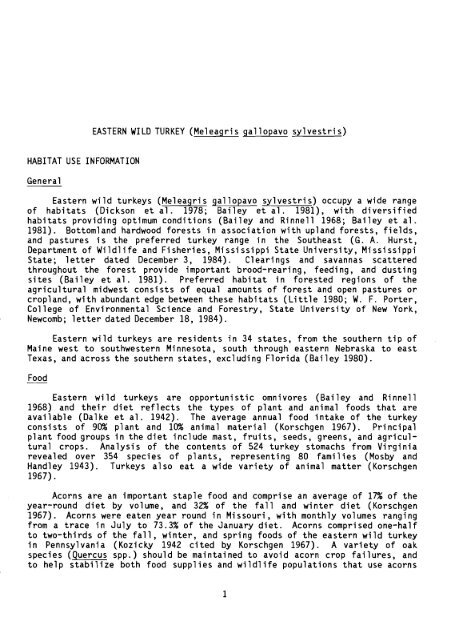habitat suitability index models: eastern wild turkey - USGS National ...
habitat suitability index models: eastern wild turkey - USGS National ...
habitat suitability index models: eastern wild turkey - USGS National ...
Create successful ePaper yourself
Turn your PDF publications into a flip-book with our unique Google optimized e-Paper software.
EASTERN WILD TURKEY (Meleagris gallopavo sylvestris)<br />
HABITAT USE INFORMATION<br />
General<br />
Eastern <strong>wild</strong> <strong>turkey</strong>s (Meleagris gallopavo sylvestris) occupy a wide range<br />
of <strong>habitat</strong>s (Dickson et al. 1978; Bailey et al. 1981), with diversified<br />
<strong>habitat</strong>s providing optimum conditions (Bailey and Rinnell 1968; Bailey et al.<br />
1981). Bottomland hardwood forests in association with upland forests, fields,<br />
and pastures is the preferred <strong>turkey</strong> range in the Southeast (G. A. Hurst,<br />
Department of Wildlife and Fisheries, Mississippi State University, Mississippi<br />
State; letter dated December 3, 1984). Clearings and savannas scattered<br />
throughout the forest provide important brood-reari ng, feedi ng, and dusting<br />
sites (Bailey et al. 1981). Preferred <strong>habitat</strong> in forested regions of the<br />
agricultural midwest consists of equal amounts of forest and open pastures or<br />
cropland, with abundant edge between these <strong>habitat</strong>s (Little 1980; W. F. Porter,<br />
College of Environmental Science and Forestry, State University of New York,<br />
Newcomb; letter dated December 18, 1984).<br />
Eastern <strong>wild</strong> <strong>turkey</strong>s are residents in 34 states, from the southern tip of<br />
Maine west to southwestern Minnesota, south through <strong>eastern</strong> Nebraska to east<br />
Texas, and across the southern states, excluding Florida (Bailey 1980).<br />
Food<br />
Eastern <strong>wild</strong> turk.eys are opportunistic omnivores (Bailey and Rinnell<br />
1968) and their diet reflects the types of plant and animal foods that are<br />
available (Dalke et al. 1942). The average annual food intake of the <strong>turkey</strong><br />
consists of 90% plant and 10% animal material (Korschgen 1967). Principal<br />
plant food groups in the diet include mast, fruits, seeds, greens, and agricultural<br />
crops. Analysis of the contents of 524 <strong>turkey</strong> stomachs from Virginia<br />
revealed over 354 species of plants, representing 80 families (Mosby and<br />
Handley 1943). Turkeys also eat a wide variety of animal matter (Korschgen<br />
1967) .<br />
Acorns are an important staple food and comprise an average of 17% of the<br />
year-round diet by volume, and 32% of the fall and winter diet (Korschgen<br />
1967). Acorns were eaten year round in Missouri, with monthly volumes ranging<br />
from a trace in July to 73.3% of the January diet. Acorns comprised one-half<br />
to two-thirds of the fall, winter, and spring foods of the <strong>eastern</strong> <strong>wild</strong> <strong>turkey</strong><br />
in Pennsylvania (Kozicky 1942 cited by Korschgen 1967). A variety of oak<br />
species (Quercus spp.) should be maintained to avoid acorn crop failures, and<br />
to help stabilize both food supplies and <strong>wild</strong>life populations that use acorns<br />
1

















